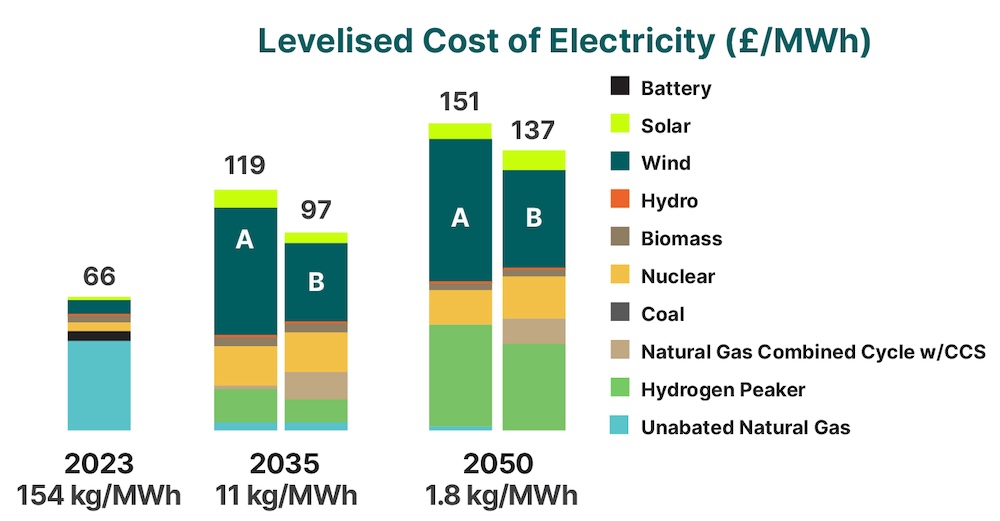With net zero deadlines inching closer, the United Kingdom is in a race to ensure it has the capacity to generate enough electricity to keep the lights on throughout the country — while meeting its own legally binding mandates for carbon reductions.
According to the U.K.’s Climate Change Committee (CCC), electricity demand in the country could double by 2050, the same year the government pledged to achieve net zero carbon emissions. In 2019, the U.K. became the first major economy to make such a target legally binding. The new Labour government, elected in July, has now set a target of 2030 to decarbonize the power system.
These are among the most ambitious targets from any nation, and reaching them will require overhauling the U.K. electrical grid and adding a substantial amount of renewable energy. But wind and solar energy together cannot decarbonize the whole power system. Reaching the last 10% to 20% will be difficult without carbon capture. Carbon capture and sequestration (CCS) is the process of capturing, transporting, and storing CO2 emissions from any industrial generator, such as power stations or manufacturing plants.
One of the solutions: gas-fired power plants with carbon capture technology. Gas power, and its ability to be turned on or off quickly as necessary, is key to making the whole system work. A GE Vernova white paper released this month, “10 GW of CCS Power Is Crucial for UK’s Energy Transition,” describes how the CCC has set an aspiration of 10 gigawatts of new power generation capacity with carbon capture by 2035. “We believe it’s going to be very important for the U.K. energy system to have carbon capture,” says Craig Jones, vice president, UK energy transition at GE Vernova, “particularly for the days when the sun’s not shining and the wind isn’t blowing.” It’s on days such as those that gas-fired peaker power plants as well as other options like nuclear and hydropower are called on.
“Ten gigawatts means possibly 15 gas-fired power plants with CCS, to support a power system with fewer carbon emissions working efficiently and effectively to help allow the U.K. to achieve its decarbonization targets.”
Opportunity for U.K. to Lead in Carbon Storage Services
The problem is that 2030 is fast approaching. And to build a new plant can take two and a half years or more, from securing approvals to producing electricity. Plus, there are the initial setup costs, especially for development of the infrastructure to handle carbon dioxide (CO2) transport and permanent storage underground. However, as more companies feed CO2 into shared pipelines, costs could decrease.
These new carbon capture storage sites not only should be competitively priced domestically; they also are expected to lure international customers. The U.K. is uniquely positioned to become a leader in providing storage services to countries with less favorable geology or policies. If the technology performs as expected, eventually the CCS segment should be self-sustaining and require little if any financial support from the U.K. government.

In addition to time and money challenges, six current gas-fired power plants are expected to be retired before 2030, making the need for new ones even more urgent. The U.K. government is expected to push for faster progress, but clearly, time is of the essence.
That’s where the Carbon Capture Alliance comes in. Each company in the international alliance, which comprises Technip Energies, Balfour Beatty, Shell, and GE Vernova, has deep roots in the U.K. The four companies collectively employ more than 21,000 people in the nation.
“This very diverse group brings together expertise across a number of different industries, aiming to ensure that the alliance can cover all technical aspects of building the U.K.’s first carbon capture gas plant,” Jones says. “It’s a good international mix of different competencies and a real example of different companies with different skills and experiences coming together to provide the full set of skills required.”
The carbon capture industry is expected to generate up to 100,000 new jobs in the U.K., either during construction or beyond. That’s particularly important in places like Teesside, an area in northeast England where one of the proposed plants is being considered — and where more traditional industries are declining. New gas-powered plants with carbon capture technology can help transition workers from oil, gas, and chemical sectors into the emerging carbon capture field. The sites under consideration for CCS plants include Net Zero Teesside Power, Whitetail Clean Energy in Salisbury, and Keadby 3 Carbon Capture Power Station in Lincolnshire.
There’s no question that CCS technology is crucial if the U.K. is to meet its legally mandated decarbonization goals — but also to help ensure a stable energy supply and provide the broader economic advantages of investing in CCS infrastructure.
“The U.K.’s current annual build rate of new energy generation may not be sufficient to achieve the ambitious 2035 target for net zero,” Jones says, “but by swiftly deploying abated technologies, carbon capture in particular, the country can help address climate change, enhance energy security, stimulate economic growth, and assert a role of leadership on the global stage.”
